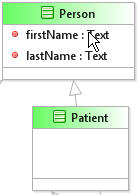Relationships
In TIBCO Business Studio, relationships are used to show the relationships between objects and consist of generalizations, associations, composition and aggregation.
Note: The terms described in this section are identical in meaning to the same terms described in UML.
Warning: Not all these types of relationship are supported for all destination environments. TIBCO Business Studio allows you to create all four types of relationship listed here, and they may all be useful for analysis purposes. However, an error will be generated if you try to deploy a business object model containing an Association or an Aggregation to BPM.
Relationships in the business object model can be grouped into two types:
- Generalizations
- Aggregation, Associations, Composition, and Aggregation. Composition and Aggregation are both more specific types of the general relationship type Association. However note that Composition is the only one of these supported in BPM.
These types can be further classified with regards to:
All relationships, except Generalizations, can have various labels when they are created in a business object model. A label name for the relationship is not displayed by default but can be added. They also display the names of the Classes and the multiplicity allowed for the Classes.
This is shown below:
Copyright © Cloud Software Group, Inc. All rights reserved.

